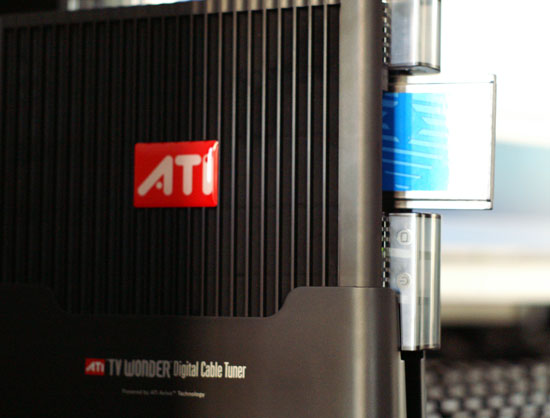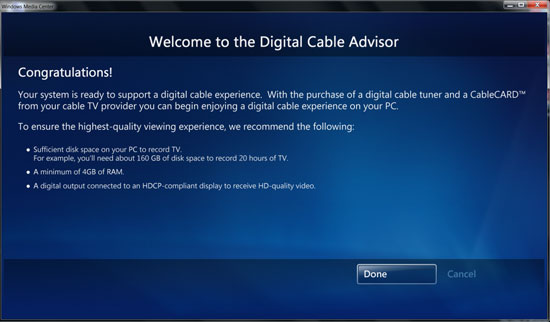The Cable Chronicles: Win7 Digital Cable Advisor Released
by Ryan Smith on November 9, 2009 12:00 AM EST- Posted in
- Ryan's Ramblings
As we mentioned in our previous edition of The Cable Chronicles, Microsoft and CableLabs have come to an agreement to allow the installation and use of CableCARDs on unapproved and non-OEM systems, allowing for the wider proliferation of CableCARD equipped HTPCs beyond the handful of OEM systems that CableLabs had previously approved. With Windows 7 implementing a complete DRM scheme for TV tuners – the Protected Broadcast Driver Architecture – computers running Win7 would be the first to be able to take advantage of these relaxed restrictions.
The limitation at the time was that computers did not come CableCARD-capable out of the box. A Digital Cable Advisor tool was to be released by Microsoft, which would check a computer to make sure it meets all of MS’s and CableLab’s requirements, before going ahead and enabling CableCARD access. That tool was supposed to be released in time for Win7’s launch, but it ended up being AWOL at the time. As Microsoft was not going to publish the complete system requirements for using a CableCARD, this tool was the only way to find out the system requirements.
The tool was finally released this weekend, allowing us to get an idea of what the system requirements are.
The tool comes as a Windows Media Center Extra, and needs to be downloaded, installed, and used from within Windows Media Center. If you don’t regularly run MCE, then it probably won’t show up in the Extras Gallery, as MCE picks up on it when it regularly checks in for updates. To force MCE to check in, go to Settings -> General -> Automatic Download Options -> Download Now.

Once installed. It shows up in your Extras Gallery.

When activated, the tool will analyze the system to determine if it meets MS/CableLab’s requirements, reporting back whether the computer passes or fails the requirements, and if it fails, offers a short explanation why.
Digging through the tool’s support files, for most of the system requirements the tool appears to just be looking at the Windows Experience Index of the computer. The chart below lists the scores we’ve found, and the text attached to them if the computer fails
| WEI Score | Attached Text | |
| Memory | 4.3 | While 2GB of RAM is sufficient for most broadcast content 4GB of RAM is recommended for the best viewing experience |
| CPU | 2.2 | A Dual Core CPU or better is recommended for the best viewing experience |
| Graphics | 3.3 | Your graphics card or driver doesn't meet the minimum requirements |
| COPP/HDCP | x | Your graphics card or driver doesn't support content protection |
| DXVA | x | We recommend that you update your video card to one that supports hardware acceleration |
In spite of the attached text, the tool doesn’t appear to actually be looking for specific pieces of hardware. We ran this test on a single-core computer with 1.5GB of RAM, and it passed anyhow, as it met the WEI scores required. So our best guess is that only WEI scores matter here.
The second test tests the Content Protection (Read: DRM) capabilities of the hardware. It appears to be looking for the various MCE DRM components (PBDA and PlayReady), HDCP support, and DXVA acceleration of MPEG-2. We suspect the DXVA check is just a warning rather than a hard error, but we don’t have any appropriate hardware to test this.
From our testing, we believe the tool will fail if HDCP support is not present in the video card, regardless of if a digital connection is being used. The big question we have, and one we haven’t been able to find an answer to, is whether HDCP is required for digital connections (e.g. an older TV using HDMI), as we don’t have a monitor on-hand that doesn’t support HDCP.
The analog situation looks better. On a PC hooked up to a TV via Component, it passed the check and was allowed to enable CableCARD support.
However once a PC passes the test, the final screen leaves us scratching our heads as to whether the tool actually knows what it’s doing.
The screen is a list of recommended hardware:
- Sufficient disk space on your PC to record TV. For example, you’ll need about 160GB to record 20 hours of TV
- A minimum of 4GB of RAM
- A digital output connected to an HDCP-compliant display to receive HD-quality video.
We’re not sure where the disagreement lies. It could very well be that the tool isn’t checking for an HDCP-attached monitor and is just blindly approving everything so long as there’s HDCP support, or that it’s downscaling content going out an analog output (ala the Image Constraint Token on Blu-Ray), or it could be that this is an empty recommendation. This tool was supposed to clear up confusion about what’s required for CableCARD use, and it hasn’t really achieved that.
Finally, in the strangest occurrence, one of our systems was already authorized according to the tool. The Core i7 rig we use for benchmarking shows up as authorized, even on a fresh install of Windows 7. This is expected behavior for OEM systems (or rather, motherboards) that were previously approved by CableLabs, but we have no idea why this would be showing up on an Asus Rampage II Extreme.

Finally, along with the release of the advisor tool, the updated firmware for the ATI TV Wonder Digital Cable Tuner needed to go with these looser restrictions has finally been released. As this was originally intended as an OEM-only product, the only place we’ve seen it thus far is at Dell’s website, where they want $210 for a tuner. Since it’s a single-stream tuner, you’ll want 2 (or more) to watch & record multiple channels. Other vendors will have CableCARD tuners out, including multi-stream tuners, but not until next year. For the time being, CableCARD on Win7 comes with a high early adopter tax.













30 Comments
View All Comments
DeesTroy - Tuesday, November 10, 2009 - link
Cable Card is strictly a USA thing. Our government saw fit to require our cable companies to come up with some method to allow other devices to be used to watch cable TV besides the crappy boxes that they shove down the throats of most people.To others, some general statements:
Centralized recording of TV with whole house distribution is where it is at and where the future of DVR should go. Having one interface, guide, and list of recorded shows is exceedingly nice. You should be able to record your shows and watch them on any TV in the house without having to fuss with anything. Media center provides this functionality, but it only works well with extenders. If you have 2 computers, you can watch unprotected TV on the second computer, but the second computer can't watch live TV shows or tell the first computer what shows to record. Total PITA and there's no reason Microsoft can't implement it, but they won't and won't tell us why. You won't be able to watch any protected shows on another computer, but you can with a Xbox or other extender. Other DVR software allows this functionality such as Sage, Media Portal, GBPVR, Myth, or Beyond TV. Unfortunately, those programs do not work with cable card, so if you want cable card, you must use Media Center and extenders.
Wireless networking rarely works with HDTV. If you plan to use wireless, you best go with N and with a router that can put the N network on its own 5GHz band separate from the B/G traffic.
darkslyde - Friday, November 13, 2009 - link
i really like the idea but that would mean implementation of a server of some sort. if MS would implement a media center server version for their win home server, that would really be a good way to realize that idea.anandtech, is there anyway y'all can do some sort of htpc revisited slash how-to in regards to a cetralized A/V home experience?
thats been my project since day one.
a "main" htpc in the living room that is capable of backing up/grabbing all media files from "satelite" computers (which WHS can already do). this main htpc must be able to run win media center (music, videos, tv, blu-ray/dvd, online content and 3rd-party wmc add-ons). as stated, the "satelite" computers or extenders has the ability to access a centralized guide; schedule shows that can be recorded (all satelite pc's will know which shows are already slotted, and let everyone know about show overlaps). the satelite pc's will be allowed to watch protected contents, but not be able to copy it (similar to itunes+appleTV). ofcourse, all shared media can be accessed according to DRM.
why go through all the trouble? i call it house clouding. centralizing = savings. all media in one location (granted WHS allows sync/share/etc options on backing up), one 1 cable-connection (vs 5 cable cards for 5 pc's that are all recording the same shows). only 1 pc needs to stay on 24/7 (recording/backups/etc). also, the benefits of WHS utilities.
anyone know of something like this that isnt linux? and before you give me the linux speech, try teaching my computer inept gf then maybe... thank you dual booting.
NKnight - Tuesday, November 10, 2009 - link
Very useful news. My HTPC just passed using an Nvidia GeForce 9400 integrated video chipset outputting over HDMI to my Kuro. I think I may just pull the trigger on a tuner now.DigitalFreak - Monday, November 9, 2009 - link
FYI - I just ran the advisor on my PC that has a Geforce 8800GTX and Dell 2405 monitor connected via DVI. The 2405 is NOT HDCP compliant, but the advisor said that I met all recommendations and enabled CableCard support. I don't actually have a CC tuner, but it looks like it will work.xp3nd4bl3 - Monday, November 9, 2009 - link
Mine also says I'm "already" configured for CableCARD. Sweet.Zero110 - Monday, November 9, 2009 - link
Been waiting for this for what seems like an eternity, but any word on two-way communication and VOD with this? It's been a long time since I researched DVR's, but my understanding is that Tivo still can't do VOD. It's the last niggling reason not to replace my hideous Comcast box.SloppyG - Monday, November 9, 2009 - link
Yeah, I would be interested if this would support VOD.I currently use a HD PVR and DVBLogic to get HD into my HTPC. Works great but having to grab a second remote to work the VOD menu (with a 3-4 second delay between presses) is a little tiring.
Added a 360 recently as an extender and am amazed by how well it works. Streamed HD fine over wifi but I went ethernet to reduce some menu latency I was experiencing. The fan (jasper chipset) is still a little on the loud side, however.
Great setup...
Ryan Smith - Monday, November 9, 2009 - link
Sorry guys, no VOD. For that you need True2Way, which is a whole new can of worms.jav6454 - Monday, November 9, 2009 - link
Yay! Finally I can a card that can do what my DVR already does /sarcasm. Now, in all seriousness, although it's a good thing I find it hampering having to deal with ecryption on many channels.jav6454 - Monday, November 9, 2009 - link
Forgot to mention any of those cards can carry quite the tag.